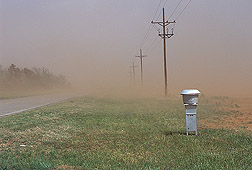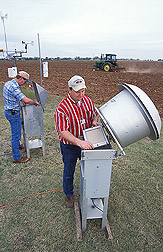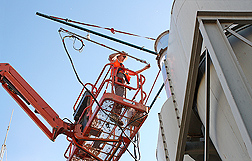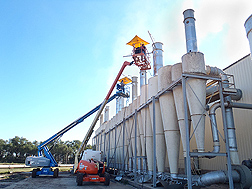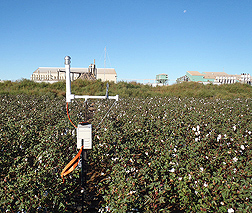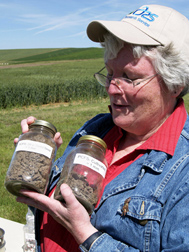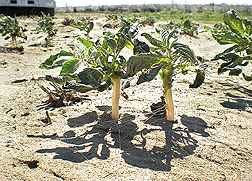Blowing in the Wind
Unless, perhaps, someone in our family has a dust allergy, most of us probably don’t think much about dust. And if we do, we probably think about the dust on our coffee tables.
Dust, however, isn’t just in our houses. It’s everywhere and can affect our health. And all dust is not created equal: The smaller particles, which are more difficult to see, are potentially the most dangerous.
In 2006, the U.S. Environmental Protection Agency (EPA) lowered the limit on average PM2.5 emissions over a 24-hour period from 65 to 35 micrograms per cubic meter. Some states have set the standard much lower. This comes from a growing concern that the smallest dust particles pose the biggest health threat, because they are small enough to penetrate deeply into peoples’ lungs.
“PM2.5” refers to particulate matter less than 2.5 microns in diameter—2.5 microns is about 1/30th the thickness of a human hair.
As states implement required plans to achieve federal standards—or even stricter ones—and begin to regulate various types of industries, they face the problem of a scarcity or, in some cases, a lack of data on how much PM2.5 those industries currently emit.
In the case of agricultural operations, EPA and the Agricultural Research Service are working together with the industries and the states to develop better science-based information and methods to set standards.
Cotton Belt Seeks “Just the Facts” on Air Pollution
Roger Isom, executive vice president of the California Cotton Ginners and Growers Association in Fresno, says that California, Arizona, and North Carolina are among the first states to begin evaluating PM2.5 emissions from agricultural and other types of industries.
Cotton gins are one of the many agricultural operations these states are looking at. As they do with other industries, the states have to decide whether to require much more expensive PM emission controls, which could risk a business’s survival. In California, the gins are already required to install enhanced cyclone pollution-control devices at all emission points. These cyclones capture cotton lint, stems and other plant parts, and soil and spin them so most of the material collects at the bottom and clean air comes out the top.
One of the options California’s San Joaquin Valley Air Pollution Control District is considering—if cotton gins are designated as “significant sources of PM2.5”—is to require “baghouses” in addition to cyclones. Baghouses are facilities that house multiple air-filter bags. These are used in other industries, including foundry and steel operations and chemical manufacturing. The bags look like large tube socks that are generally 6 to 10 inches in diameter and often are 10 to 20 feet long.
$1 Million-Plus Controls May be Too Much for Cotton Gins
|
|
Agricultural engineer Mike Buser, formerly with ARS and now at Oklahoma State University at Stillwater, says that “one of the California gins we tested has 13 separate air-quality emission systems. That gin would have to have two baghouses, each holding about 500 bags. That would cost more than $1 million.”
Isom shares the concerns of gin associations throughout the cotton belt—which stretches from California to North Carolina—that the lack of data could lead to an erroneous overestimation of PM2.5 emissions. So they pressed for research to find out how much gins actually emit.
Cotton gins in states like Missouri are already finding it difficult to obtain air-quality permits to operate, because the standards are based on EPA models that are more suited to industrial smokestacks. Gins’ exhaust pipes are much closer to ground level, mostly 30 feet high, with the tallest ones usually no more than 65 feet high, so their emissions tend not to travel far from the gin. These models may overestimate the distance gin dust travels by 10 times.
Urban Samplers, Models Wrong for Cotton Gins?
Buser found that EPA samplers could be overestimating PM2.5 emission concentrations by 14 times. Buser was at the ARS Cotton Production and Processing Research Unit in Lubbock before transferring to Oklahoma State University in 2009. He continues his research as an integral part of the “Characterization of Cotton Gin Particulate Matter Emissions Project.”
Isom, well aware of Buser’s research, called Buser in 2007 and asked for help in getting scientific answers on PM2.5 concentrations.
So, in 2008, ARS scientists at cotton ginning labs—including Buser; Derek Whitelock, an agricultural engineer with the ARS Southwestern Cotton Ginning Research Laboratory in Mesilla Park, New Mexico; and fellow agricultural engineer Clif Boykin, at the ARS Cotton Ginning Research Unit in Stoneville, Mississippi— organized a major 4-year project to intensively sample emissions from seven cotton gins strategically located throughout the Cotton Belt. From the very start, they planned the project with federal and state regulators and the cotton industry to address the various concerns of each cotton-growing region.
“Texas, for example, wanted more information on the total amount, size, and percentages of all the particles emitted from gins, including PM10. The cotton growers’ and ginners’ organizations wanted more accurate computer models to predict emissions,” Buser says.
To accurately determine the total emissions—PM10 and PM2.5—from a cotton gin, they directly sample the exhaust from the gin’s many cyclones, using EPA methods. To do this, the scientists joined forces with a certified stack tester from California to measure the PM emissions from cotton gins.
They also measure the level of PM2.5 and PM10 in the air outside a cotton gin by surrounding each gin with 126 ambient air samplers, compared to the half-dozen samplers used in previous, less intensive, studies. There are 6 sampling points at different levels on each of 12 towers. Each tower is 33 feet tall.
Whitelock says, “More than 1,500 samples are brought back from each gin for processing,” which is done in the ARS Air Quality Laboratory at Lubbock, under the direction of research leader Greg Holt.
Intensive Air Sampling
They have already sampled one gin in New Mexico, two in Texas, two in California, and one in Missouri. In 2011, they’ll test the last gin, in North Carolina.
It will take another year, through 2012, to analyze the data from all the tests. California officials and gin associations are especially anxious for the project data on their two gins, giving them the first real numbers to work with.
Whitelock says that he, Buser, and Boykin “set up a gin advisory group and an air-quality advisory group to help us plan the project, and we always invite cotton gin associations and regulators to observe each sampling campaign.”
The gin advisory group includes people from cotton gin associations; Cotton Incorporated, whose world headquarters are in Cary, North Carolina; the National Cotton Council of America in Cordova, Tennessee; and Texas A&M University at College Station. It was formed to identify prospective gins for sampling and to act as liaison between the gins and ARS.
The air-quality advisory group includes people on the gin advisory group as well as from EPA and state environmental regulatory agencies and the U.S. Department of Agriculture. This group was formed to advise on methods and equipment for sampling, quality control, and data analysis.
“Participation of these advisory groups is essential to the success of this project and for the results to be accepted by industry and regulators,” Whitelock says. “This way we have their buy-in on our data-collection methods before we ever start, minimizing the chances of having our results questioned after the experiments are over,” Whitelock says.
Funding for the project comes from several sources, with a long list of cooperators.
“With cotton-production costs soaring, all decisions on more costs have to be based on sound science. That is key to ensuring that the U.S. cotton industry remains strong and competitive globally,” Whitelock says.
|
|
Pacific Northwest Farmers Can See Soil Blow Away
EPA’s regulations on PM2.5 and PM10 affect every aspect of agriculture, not only cotton gins but also cattle feedlots and farming operations.
For the Columbia Plateau region of the Pacific Northwest, the focus is on topsoil blowing in the wind: The smaller particles occasionally contribute to poor air quality in the region.
Farmers in this wind-erosion-prone region are as anxious as any others about the prospect of farms being regulated like cotton gins and other industries, with fears of urban air-pollution samplers surrounding their farmland. But they also want their rich topsoil to stay in place, so they are eager to reduce wind erosion.
Brenton Sharratt and Ann Kennedy, at the ARS Land Management and Water Conservation Research Unit in Pullman, Washington, are identifying practices that will keep the soil from blowing away.
Sharratt, research leader of the unit, examines the physical properties, and Kennedy, a soil scientist, studies the biological properties of soils that affect wind erosion.
Sharratt measures the quantity and size of soil particles blown off fields while Kennedy analyses the soil for its lipid content from the microbes living in the soil. Each microbe community has a unique fingerprint that can be used to identify the soil. Sediment deposited far downwind of a field can potentially be traced back to where it blew from.
Although she and Sharratt focus on soils of the Columbia Plateau region in parts of Idaho, Oregon, and Washington State, Kennedy also works with ARS scientists in Colorado, Idaho, Missouri, and Texas on fingerprinting soils. The scientists exchange soil samples to study a variety of soils from different regions. Interestingly, microbial communities from dirt and gravel roads differed from adjacent agricultural soils whether in Washington or Texas.
“Apparently, the microbial communities found on roads change with time because of the lack of plants and restricted water infiltration,” Kennedy says.
They collect samples from devices that trap blowing soil particles; these devices were invented by ARS scientists in Lubbock.
Sharratt is investigating how soil and crop management affects the amount of soil and PM10 eroded from fields during high winds. Tillage and crops can influence soil roughness, soil aggregation (or size of soil clods), and the quantity of crop residue on the soil surface. All these factors affect the soil’s susceptibility to erosion by wind or water. He is also looking at how soil moisture and crusting can protect the soil from wind erosion.
“Maintaining roughness and nonerodible material such as crop residue on the soil surface is key to controlling wind erosion” Sharratt says. “We’re looking for ways to manage soils that minimize blowing and are cost effective for the farmer.”
Ultimately, Sharratt, Kennedy, and their colleagues are looking for management practices that reduce the soil’s vulnerability to wind erosion. They know that no-till—eliminating plowing or frequent tillage before planting, leaving adequate amounts of protective residue from previous crops on the surface—is very effective at reducing wind erosion and PM10 emissions from agricultural lands. But no-till is often not economically viable in the very driest parts of the Columbia Plateau. There are challenges yet to be worked out before no-till systems can be used with success throughout the region.
One tillage technique that seems promising is undercutting, which slices beneath the soil surface and gently lifts and sets down the uppermost layer of soil in place. Undercutting severs the roots of weeds without inverting the soil as a plow does.
“Undercutting has reduced soil and PM10 loss from fields during high wind events by as much as 65 percent as compared to conventional tillage practices in the drier parts of the region,” Sharratt says. “This breaks open compacted layers and breaks up harmful fungi, while leaving the soil and organic matter intact, with positive effects on beneficial microbes,” Kennedy says.
“We always thought that most of the carbon that makes up organic matter was lost to the atmosphere as carbon dioxide,” Kennedy says. “But we have found that a lot of organic matter is actually being lost to the wind as soil blows off a farm field, as much as 10 percent of total organic matter losses. This is one more incentive, as though any were needed, for farmers to keep the soil in place. ”—By Don Comis, Agricultural Research Service Information Staff.
This research supports the USDA priority of responding to climate change and is part of Climate Change, Soils, and Emissions (#212), an ARS national program described at www.nps.ars.usda.gov.
To reach scientists mentioned in this story, contact Don Comis, USDA-ARS Information Staff, 5601 Sunnyside Ave., Beltsville, MD 20705-5129; (301) 504-1625.
|
|
Predicting Pathways for Windblown Dust
An Agricultural Research Service scientist and partners have combined models of wind erosion and regional climate patterns to simulate the sources and dispersion of particulate matter—such as tiny bits of soil and other substances—blowing in dust storms around Mexico City.
People who inhale particulates with a diameter of 10 micrometers or less (PM10) can develop respiratory problems, so public health officials are anxious to predict how these airborne pollutants are dispersed over time.
Soil scientist John Tatarko, who works at the ARS Engineering and Wind Erosion Research Unit in Manhattan, Kansas, collaborated with scientists at the National Autonomous University of Mexico on this research. His partners included Emmanuel Díaz, Arón Jazcilevich, Agustín García, Ernesto Caetano, and L. Gerardo Ruíz-Suárez.
The team combined two existing models to explore how wind erodes PM10 from farm fields and dry lakebeds around Mexico City, where poor air quality is an ongoing concern. The first model was the Wind Erosion Prediction System (WEPS), which was developed by ARS scientists to simulate rates of soil loss, PM10 emissions, and other data for specific erosion events.
The other model, developed at the Karlsruhe Institute of Technology in Germany, was the Multiscale Climate and Chemistry Model (MCCM). It combines information about weather conditions and other factors to produce estimates of the transport of air pollutants. The combined model system was called “MCCM-WEPS.”
The researchers collected field data on four dust storms around Mexico City during the dry season. Then they compared PM10 erosion rates from these storms with MCCM-WEPS simulations of erosion rates for the same storms.
The team found that the simulated rates produced by MCCM-WEPS generally aligned with the PM10 erosion rates that had been measured from the dust storms—and accurately simulated the PM10 dispersion downwind. The model also suggested that the horizontal transport of PM10 accelerates when wind currents mix and form low-pressure systems, which prompt the upward movement of the particulates. These combined findings all indicate that wind erosion is a major cause of high PM10 concentrations in Mexico City.
Results from this research were published in 2010 in Aeolian Research.—By Ann Perry, Agricultural Research Service Information Staff.
"Blowing in the Wind" was published in the July 2011 issue of Agricultural Research magazine.







